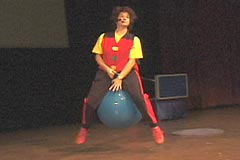
What do you get when you cross circus skills, science concepts and a couple of wacky characters? You get Fizzical Fizzicks - an interactive, action-packed show about the science of motion! It all began when Greg Tarlin and Kristi Heath created the show for the Ontario Science Centre. Ever since, Fizzical Fizzicks has been playing to enthusiastic audiences across Canada and the USA.
The Circus
This is no dry science lecture! Audiences will be delighted as this dynamic duo performs circus skills like juggling, stilt-walking and unicycling; PLUS dozens of tricks with toys like yo-yos, hula hoops and even a pogo stick. There are a few BIG surprises in store as giant, colourful props get involved in the action.The Science
Fizzical Fizzicks is based on themes of force and motion. It also touches on other science topics like waves, friction, momentum and air resistance.The Audience
A big part of the fun comes when teams from the audience are invited to help demonstrate different types of motion with challenges like spinning on the spot, throwing a ball and even skipping. These segments are always tons of fun and emphasize the importance of teamwork. To finish the show, Greg and Kristi perform their thrilling Big Circus Trick. They balance atop towering stilts and a 6-foot unicycle, spin plates on their heads and toss juggling clubs around a volunteer. This finale perfectly blends all three types of motion with amazing circus flair.








